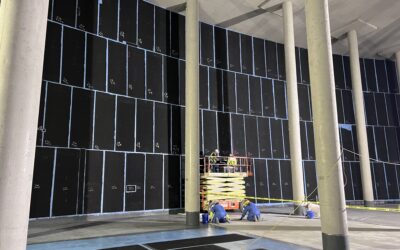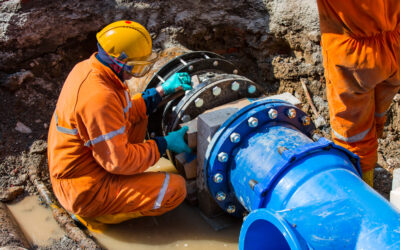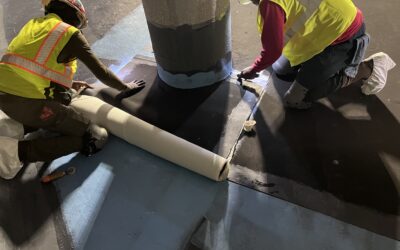Protecting industrial pipes from corrosion, abrasion, and chemical damage is critical for ensuring efficient and long-lasting operations. In many cases, rubber lining is the most effective material for the job.
Below is an explanation of when and why rubber lining is a solid choice so you can make an informed decision about whether it’s the right protective measure for your application.
Industries and Applications That Benefit From Rubber-lined Pipes
Rubber lining is used across numerous industries where the pipes must endure extreme temperatures, corrosion, abrasion, or chemical attacks. Some common ones are:
- Mining and mineral processing
- Petrochemical processing
- Water treatment
- Power generation and utility systems
- Pulp and paper production
- Food and beverage processing
- Railcar applications
- Nuclear processes
- Steel mill operations
Why Rubber Lining? 5 Benefits of Rubber-lined Pipes
Rubber lining pipes for industrial use helps protect equipment, extend its lifespan, and minimize maintenance costs. Rubber-lined pipes add value through:
1. Chemical Resistance
Rubber provides exceptional resistance to a wide range of chemicals. This feature prevents chemical degradation and corrosion, helping pipes maintain structural integrity in the presence of harsh agents.
2. Abrasion Resistance
Rubber-lined pipes can handle abrasive materials like slurry, sand, and other particulates better than bare metal pipes. This abrasion resistance is crucial for industries like mining, where wear and tear from abrasive materials is constant. Rubber’s elastic nature also absorbs impact better, reducing the chance of damage from collisions or vibrations.
3. Microbiological Resistance
Rubber linings are non-porous, which minimizes microbial growth within pipes — a critical feature for industries such as water treatment and food processing. Certain rubbers are also formulated to resist mold and bacteria growth, maintaining cleaner pipelines and ensuring the purity of transported fluids.
4. Thermal and Impact Resistance
Rubber linings can withstand extreme temperatures and pressures without deforming. This thermal resilience prevents cracking and damage from temperature fluctuations, making rubber-lined pipes well-suited for steam applications in power plants and utility systems.
5. Enhanced Equipment Longevity and Lower Maintenance
By reducing corrosion, abrasion, and impact damage, rubber lining ultimately extends the life of pipes and lowers repair costs. By protecting pipes from the most common causes of wear, companies can decrease downtime and focus maintenance budgets on preventive care instead of reactive repairs.
Common Types of Rubber for Pipe Lining
Selecting the right type of rubber lining depends on what the pipe is used for, where it is used, the materials it will transport, and any relevant industry standards. Some of the most common types used are:
- Natural rubber: Best in mining and other industries that transport slurry.
- Neoprene (Polychloroprene): Best in applications with oils or moderately corrosive chemicals, such as water treatment.
- EPDM (Ethylene Propylene Diene Monomer): Best in chemical processing and water treatment applications.
- Butyl Rubber: Best in chemical processing and whenever pipes need an airtight, resilient lining.
- Chlorobutyl: Best in high-temperature and high-pressure environments, like power and chemical plants.
How Thick Should Pipe Rubber Lining Be?
The thickness of rubber lining for industrial pipes can vary depending on the pipe’s intended use, the abrasiveness of the materials being transported, and the expected lifespan of the pipeline.
Generally, rubber lining for pipes ranges from 1/8 inch to 1/4 inch (3.2 mm to 6.4 mm), but custom applications may require different thicknesses.
- Light- to medium-duty applications: Pipes handling mild chemicals or low-abrasion materials typically use thinner linings, around 1/8 inch (3.2 mm).
- Heavy-duty applications: High-abrasion or high-chemical exposure environments, such as mining and chemical processing, may require thicker linings, up to 1/4 inch (6.4 mm) or even more. The added thickness provides greater durability, extending the life of the lining and reducing the frequency of replacement.
Final Considerations Before Implementing Rubber-lined Pipes
When deciding whether to use rubber-lined pipes, consider the following:
Less (but Not Non-existent) Pipe Maintenance Requirements
Rubber-lined pipes require less frequent maintenance, but you (or a licensed rubber lining contractor) will still need to inspect them periodically for any signs of wear or damage.
Cost-Effectiveness
While rubber-lined pipes might have a higher upfront cost, they often result in lower long-term expenses due to reduced repairs and longer service life.
Compatibility with Transported Substances
Ensure that the type of rubber selected is compatible with the materials the pipes will carry. Mismatched linings can lead to premature failure. A certified rubber lining professional can help you make the right choice.
Environmental and Safety Regulations
Some applications require rubber linings that meet specific industry or environmental standards, such as food-grade rubber for food and beverage processing. Again, a professional rubber lining contractor will know what’s best for your industry.
Ready to Rubber Line? Contact Our Team
Investing in rubber lining for industrial pipes ultimately contributes to a safer, more efficient operation, with reduced costs over time and improved industrial equipment protection. With the right rubber-lined pipes in place, you can confidently meet your operational needs while ensuring a stable infrastructure that can withstand the test of time.
To learn more about our rubber lining capabilities at US RUBBER, contact us online.







